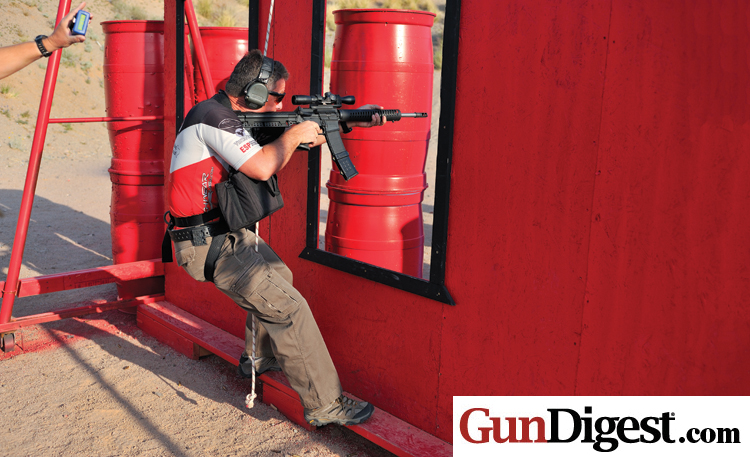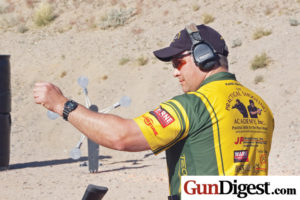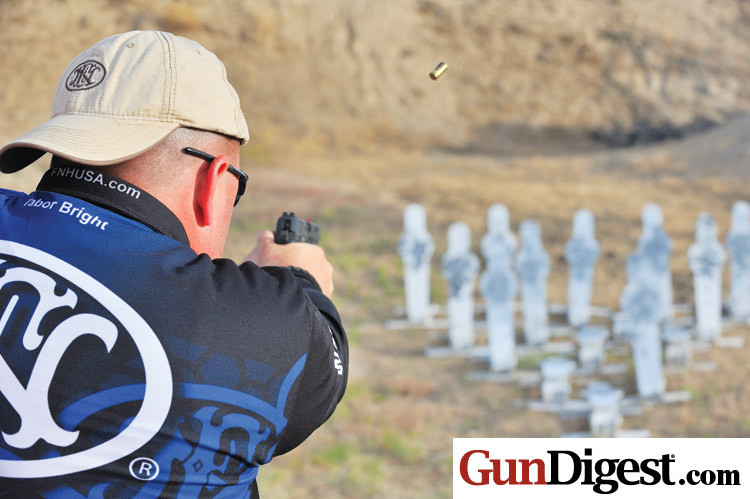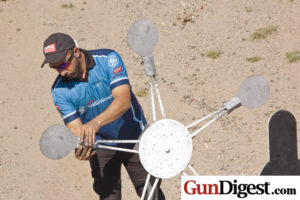

Editor's Note: This article is an excerpt from the Complete Guide to 3-Gun Competition book, available now at GunDigestStore.com.
The sport of 3-gun competition falls within the discipline known as “action shooting,” which really is a politically correct term for practical shooting, the sport based on the quest for a higher level of combat shooting. While action shooting has been formally presented in America now for several decades, it has taken various shapes.
Today, action shooting has many forms, most of which traces itself back to the formation of the International Practical Shooting Confederation, or IPSC. Later, the United States Practical Shooting Association was formed as the U.S. domain of IPSC, as IPSC is truly international and branches into many countries around the world. The USPSA remains the strongest region, boasting more than 20,000 members nationwide.

The International Defensive Pistol Association (IDPA) is an offshoot of IPSC-style shooting, formed by shooters unsatisfied with the “gamesmanship” perceived to be prevalent within USPSA matches and rules. IDPA currently claims more than 19,000 members, and its competitions differ from IPSC’s primarily in their rules structure, which establish competitions leaning more towards self-defense or tactical-style shooting, rather than a test of pure shooting skills, as some view the matches of IPSC.
Both USPSA/IPSC and IDPA have been extremely successful in the U.S., but primarily as organizations that promote and sanction pistol competition. Three-gun competition, while influenced by USPSA rules already in place, has developed outside the vacuum of any one governing body, although 3-Gun Nation is quickly becoming the entity that bridges many matches and clubs together.
An event, or match, is a collection of individual courses of fire, commonly called “stages.” During each stage of multiple targets, a competitor, under the direction of a range officer, negotiates that stage—and keep in mind this is an action sport, so there’s lots of moving around from place to place, from one bank of targets to another, and so on—engaging each target as described during the stage briefing given by the range officer before the timer buzzer goes off.
That briefing varies in its instructions, ranging from strictly regimented courses that must be shot in a specific sequence, to free-form design, where the competitor is free to map their own strategy. A stage can have a specific starting area as limited as a small “starting box,” outlined by wood or metal staked into the ground. Stages can also have specific shooting areas, where certain targets must be engaged using particular firearms. Fault lines are also sometimes present, marking the end of the area of movement for a competitor—no shots may be fired outside of a shooting area or forward of a fault line without receiving penalty, which is applied to a shooter’s score in extra time.
After the stage briefing, the squad—a designated number of competitors that rotate through the match shooting each of the stages as a unit—is allowed a walk through period. Often limited to five minutes, competitors get a chance to see each target, walk the stage as they anticipate they’ll run it when it’s their time to shoot—this might include planning out where best to reload, how to approach and shoot over, under, or around a barricade, etc.—and ask any questions of the range officer.
It’s here that a 3-gun competition stage can get a bit complicated and even confusing. At a given match, there are numerous types of targets one might encounter. There are multiple sizes and types of paper targets, with the IPSC-style cardboard torso/head target the most common. (3-Gun Nation recently developed a new bull’s-eye-type paper target that will likely become more common in local club matches.)

Steel targets also show up in various forms, ranging from simple knock-over pieces of circular or rectangular steel sitting on top of a target stand, to advanced steel target systems manufactured by MGM Targets and others. Hinged “poppers,” also known as “plate racks” (six or more pieces of circular steel affixed to a target stand), static steel plates affixed to target stands, and reactive steel targets that move when struck are all used.
Auto poppers are popular for rifle stages—here, the popper goes down when hit, then mechanically resets itself without anyone having to go downrange. Most reactive steel targets require a range officer to call “hits” when used in competition. Clay birds are another common target, and they’re usually found in the form of a static target placed on a target stand. Clays are also thrown, as they might be in traditional sporting clays, trap, or skeet clay bird games, on some stages, adding a further degree of difficulty to 3-gun competition.

Moving targets offer yet another challenge. Often activated when a popper is knocked down, these limited-exposure targets come in many forms. Usually a paper target, the presentation can be moving from side-to-side, often only partially exposed. It can also turn towards the competitor, and then away again after a moment. There is also an “attack target” which accelerates toward the competitor before disappearing out of view. Limited-exposure targets can be extremely challenging!
Finally, there are the specialty targets—Texas Stars, Spinners, the Propeller Rack—that use gravity and balance to move in various directions. There are many specialty targets, especially the popular ones from MGM Targets, that provide fun and challenging shooting in 3-gun competition.
Ultimately, depending upon the stage description given by the range officer, all of these different types of targets and presentations can be presented for specific or multiple firearms within a given stage—that means 3-gun competition is a thinking man’s game as much as it is one of pure shooting fundamentals and skill.
As with most action shooting sports, 3-gun competition is one that is measured in time. When shooting a stage, the competitor, under the direction of the range officer, will “stage” any firearms (i.e., put them in various places throughout the stage for pickup and use when they get to that portion), and, finally, receive the command to “make ready,” with a specific firearm.
Then, holding a timer that tracks each audible shot, the range officer pushes the timer’s button, a “beep” goes off, and competitor’s rip through stages as fast as their skills allow. At the end of the stage, the raw time it took the shooter to complete the stage is recorded, then any penalties for procedurals or targets missed are applied to form a final stage time, or score. Each stage time is added up, and, as it is with golf, where the fewest strokes win a match, the 3-gun competitor who finishes an event the quickest, penalties included, is the match winner.
Matches themselves vary in size (both competitor number and venue), and form. Major Matches, such as Superstition Mountain Mystery 3-Gun competition, in Arizona, which I’ll cover later in this book, feature 250 or more shooters, utilize a wide array of props and targets, and boast some of the fastest, wide-open types of stages in 3-gun competition. They often consist of short stages confined to three-wall bermed shooting bays, and the targets and scoring system combine to promote extremely fast shooting.
Blue Ridge Mountain 3-gun, conversely, is a Major Match situated in the rolling hills of Kentucky, which provides a tremendously challenging natural terrain course of fire, one that is also very physical. The scoring and target placement penalize inaccuracy, especially with a rifle, so Blue Ridge becomes a very physical, accuracy-oriented test of skills.
At the local level, match stages are most often contained in shooting bays and limited to 100 yards, although some clubs certainly have the ability to hold long-range rifle stages. Fields of competitors can be anywhere between 20 and 100 in a one-day local club match, offering a wide range of shooting experiences. No matter what the size or location of the shoot, scoring formulas, rule structures, target presentations, and match styles can vary wildly in the sport—there is, quite literally, a different face to 3-gun competition nearly everywhere you go. But, this is part of its core, and just one of the many reasons 3-gun competition remains the most exciting discipline in all of shooting.
Keep Reading About 3-Gun Competitions
 This article is actually the first chapter from the hit book, Complete Guide to 3-Gun Competitions. It's full of in-depth information on 3-gun competitions. The book is perfect for anyone looking to get into this exciting sport or competitors looking to up their game.
This article is actually the first chapter from the hit book, Complete Guide to 3-Gun Competitions. It's full of in-depth information on 3-gun competitions. The book is perfect for anyone looking to get into this exciting sport or competitors looking to up their game.
Click here to order the Complete Guide to 3-Gun Competitions book from GunDigestStore.com.

![Best Concealed Carry Guns In 2025 [Field Tested] Wilson Combat EDC X9S 1](https://gundigest.com/wp-content/uploads/Wilson-Combat-EDC-X9S-1-324x160.jpg)


![Best 9mm Carbine: Affordable PCCs [Tested] Ruger Carbine Shooting](https://gundigest.com/wp-content/uploads/Ruger-Carbine-Shooting-100x70.jpg)
![Best AR-15: Top Options Available Today [Field Tested] Harrington and Richardson PSA XM177E2 feature](https://gundigest.com/wp-content/uploads/Harrington-and-Richardson-PSA-XM177E2-feature-100x70.jpg)
